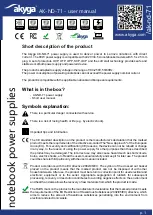
4
English
APPLICATIONS
○
Cutting various lumber and pocket cutting
○
Cutting mild steel plate, aluminum plate, and copper
plate
○
Cutting synthetic resins, such as phenol resin and vinyl
chloride
○
Cutting thin and soft construction materials
○
Cutting stainless steel plate (with No. 97 blade)
SPECIFICATIONS
Voltage (by areas)*
(110 V, 120 V, 220 V, 230 V,
240 V)
Power Input*
800 W
Max. cutting depth
Wood 160 mm
Mild steel 10 mm
No-load speed*
800 – 2800 /min
Stroke
26 mm
Min. cutting radius
25 mm
Weight (without cord)
2.5 kg
* Be sure to check the nameplate on product as it is subject
to change by areas.
NOTE
Due to HITACHI’s continuing program of research and
development, the speci
fi
cations herein are subject to
change without prior notice.
MOUNTING AND OPERATION
Action
Figure
Page
Changing blades
2
30
Adjusting the blade operating speed*1
3
30
Switch operation
4
31
How to use the LED light
5
31
Adjusting the orbital operation
6
31
Splinter guard
7
31
Sub base*2
8
32
Chip cover
9
32
Housing the hexagonal bar wrench
10
32
Mounting the guide
11
32
Rectilinear cutting
12
32
Cutting a circle or a circular arc
13
32
Cutting metallic materials
14
33
Angular cutting
15
33
Pocket cutting
16
33
Concerning cutting of stainless steel
plates
17
34
Connecting with cleaner
18
34
Selecting accessories
―
35
*1 The tool is equipped with two modes: “Standard Mode”
and “AUTO Mode”.
(1) Standard Mode
You can change the blade operating speed between
800 to 2800 /min by adjusting the dial from “1” to “5”.
(2) AUTO Mode
Depending on the workload, AUTO Mode “A” will
automatically change the blade operating speed
to 1400 /min or 2800 /min. This has the e
ff
ect of
lowering vibration and noise prior to and during
operation.
Adjust the dial for the mode and speed that best suits
your task conditions and materials.
Blade operating speed
Mode
Dial
Blade operating speed
Standard Mode
1 – 5
800 – 2800 /min
AUTO Mode
A
No load: 1400 /min
With load: 2800 /min
With AUTO Mode, the vibration frequency may not reach
2800 /min or return to 1400 /min depending on variables
such as the type of work.
NOTE*2
When the sub base is attached, the blade’s protrusion
from the material being cut will be reduced by 3mm.
When the blade has been moved down to the lowest
point, check to make sure that it is protruding from the
material.
SELECTION OF BLADES
Accessory blades
To ensure maximum operating e
ffi
ciency and results, it is
very important to select the appropriate blade best suited to
the type and thickness of the material to be cut. Three types
of blades are provided as standard accessories. The blade
number is engraved in the vicinity of the mounting portion
of each blade. Select appropriate blades by referring to
Table 1
.
MAINTENANCE AND INSPECTION
1. Inspecting the blade
Continued use of a dull or damaged blade will result in
reduced cutting e
ffi
ciency and may cause overloading of
the motor. Replace the blade with a new one as soon as
excessive abrasion is noted.
2. Inspecting the mounting screws
Regularly inspect all mounting screws and ensure that
they are properly tightened. Should any of the screws be
loose, retighten them immediately. Failure to do so could
result in serious hazard.
3. Maintenance of the motor
The motor unit winding is the very “heart” of the power
tool. Exercise due care to ensure the winding does not
become damaged and/or wet with oil or water.
4. Inspecting the carbon brushes
For your continued safety and electrical shock
protection, carbon brush inspection and replacement
on this tool should ONLY be performed by a HITACHI
AUTHORIZED SERVICE CENTER.
5. Replacing supply cord
If the supply cord of Tool is damaged, the Tool must be
returned to Hitachi Authorized Service Center for the
cord to be replaced.
CAUTION
In the operation and maintenance of power tools, the
safety regulations and standards prescribed in each
country must be observed.
0000Book̲CJ160V̲Asia.indb 4
0000Book̲CJ160V̲Asia.indb 4
2015/05/27 16:02:37
2015/05/27 16:02:37





































